Image Segmentation
- Non-contextual thresholding
- Contextual segmentation: Region growing
- Texture segmentation: Spectral features
- References
Segmentation techniques are either contextual or non-contextual. The latter take no account of spatial relationships between features in an image and group pixels together on the basis of some global attribute, e.g. grey level or colour. Contextual techniques additionally exploit these relationships, e.g. group together pixels with similar grey levels and close spatial locations.
Non-contextual thresholding
Thresholding is the simplest non-contextual segmentation technique. With a single threshold, it transforms a greyscale or colour image into a binary image considered as a binary region map. The binary map contains two possibly disjoint regions, one of them containing pixels with input data values smaller than a threshold and another relating to the input values that are at or above the threshold. The former and latter regions are usually labelled with zero (0) and non-zero (1) labels, respectively. The segmentation depends on image property being thresholded and on how the threshold is chosen.Generally, the non-contextual thresholding may involve two or more thresholds as well as produce more than two types of regions such that ranges of input image signals related to each region type are separated with thresholds. The question of thresholding is how to automatically determine the threshold value.
Simple thresholding
The most common image property to threshold is pixel grey level: g(x,y) = 0 if f(x,y) < T and g(x,y) = 1 if f(x,y) ≥ T, where T is the threshold. Using two thresholds, T1 < T1, a range of grey levels related to region 1 can be defined: g(x,y) = 0 if f(x,y) < T1 OR f(x,y) > T2 and g(x,y) = 1 if T1 ≤ f(x,y) ≤ T2.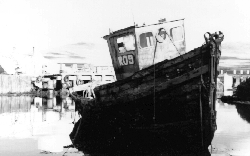 |  | |
| Greyscale image "Boat" | Its grey level histogram | |
 |  | 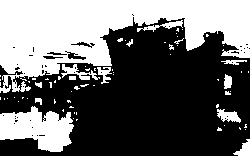 |
| Binary regions for T = 26 | Binary regions for T = 133 | Binary regions for T = 235 |
 |  |  |
| Greyscale image "Baboon" | Its grey level histogram | Binary regions for T = 159 |
A general approach to thresholding is based on assumption that images are multimodal, that is, different objects of interest relate to distinct peaks (or modes) of the 1D signal histogram. The thresholds have to optimally separate these peaks in spite of typical overlaps between the signal ranges corresponding to individual peaks. A threshold in the valley between two overlapping peaks separates their main bodies but inevitably detects or rejects falsely some pixels with intermediate signals. The optimal threshold that minimises the expected numbers of false detections and rejections may not coincide with the lowest point in the valley between two overlapping peaks:

Adaptive thresholding
Since the threshold separates the background from the object, the adaptive separation may take account of empirical probability distributions of object (e.g. dark) and background (bright) pixels. Such a threshold has to equalise two kinds of expected errors: of assigning a background pixel to the object and of assigning an object pixel to the background. More complex adaptive thresholding techniques use a spatially varying threshold to compensate for local spatial context effects (such a spatially varying threshold can be thought as a background normalisation).A simple iterative adaptation of the threshold is based on successive refinement of the estimated peak positions. It assumes that (i) each peak coincides with the mean grey level for all pixels that relate to that peak and (ii) the pixel probability decreases monotonically on the absolute difference between the pixel and peak values both for an object and background peak. The classification of the object and background pixels is done at each iteration j by using the threshold Tj found at previous iteration. Thus, at iteration j, each grey level f(x,y) is assigned first to the object or background class (region) if f(x,y) ≤ Tj or f(x,y) > Tj, respectively. Then, the new threshold, Tj+1 = 0.5(μj,ob + μj,bg) where μj,ob and μj,bg denote the mean grey level at iteration j for the found object and background pixels, respectively:

Colour thresholding
Color segmentation may be more accurate because of more information at the pixel level comparing to greyscale images. The standard Red-Green-Blue (RGB) colour representation has strongly interrelated colour components, and a number of other colour systems (e.g. HSI Hue-Saturation-Intensity) have been designed in order to exclude redundancy, determine actual object / background colours irrespectively of illumination, and obtain more more stable segmentation. An example below (from http://www.matrix-vision.com/products/software) shows that colour thresholding can focus on an object of interest much better than its greyscale analogue:
Greyscale vs. colour thresholding

where g(x,y) is the binary region map after thresholding. This thresholding rule defines a sphere in RGB space, centred on the reference colour. All pixels inside or on the sphere belong to the region indexed with 1 and all other pixels are in the region 0.
Also, there can be an ellipsoidal decision surface if independent distance thresholds are specified for the R, G, and B components. Generally, colour segmentation, just as the greyscale one, may be based on the analysis of 3D colour histograms or their more convenient 2D projections. A colour histogram is built by partitioning of the colour space onto a fixed number of bins such that the colours within each bin are considered as the same colour. An example below of the partitioned 11×11×11 RGB colour space is from (http://www.owlnet.rice.edu/~elec301/Projects02/artSpy/color.html):

How fine should be the partitioning depends on the application domain. In many cases colour segmentation exploits only a few dominant colours corresponding to distinct peaks of the pixel-wise colour distribution (both the images and histograms below are from ij-plugins.sourceforge.net/ij-vtk/color-space/):
 |  |
| Colour image "Baboon" | Its colour 6×6×6 histogram (sphere-size-coded bin values) |
 |  |
| Colour image "Clown" | Its colour 6×6×6 histogram (sphere-size-coded bin values) |
 | 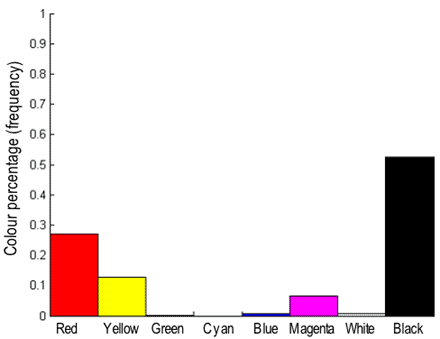 |  |
| Digitised Rembrandt's canvas | Colour 8-bin histogram | Regions of the primary colours |
| (www.abcgallery.com/R/rembrandt/) | (http://rsb.info.nih.gov/ij/plugins/color-inspector.html) | |
Contextual segmentation: Region growing
Non-contextual thresholding groups pixels with no account of their relative locations in the image plane. Contextual segmentation can be more successful in separating individual objects because it accounts for closeness of pixels that belong to an individual object. Two basic approaches to contextual segmentation are based on signal discontinuity or similarity. Discontinuity-based techniques attempt to find complete boundaries enclosing relatively uniform regions assuming abrupt signal changes across each boundary. Similarity-based techniques attempt to directly create these uniform regions by grouping together connected pixels that satisfy certain similarity criteria. Both the approaches mirror each other, in the sense that a complete boundary splits one region into two.Pixel connectivity
Pixel connectivity is defined in terms of pixel neighbourhoods. A normal rectangular sampling pattern producing a finite arithmetic lattice {(x,y): x = 0, 1, ..., X−1; y = 0, 1, ..., Y−1} supporting digital images allows us to define two types of neighbourhood surrounding a pixel. A 4-neighbourhood {(x−1,y), (x,y+1), (x+1,y), (x,y−1)} contains only the pixels above, below, to the left and to the right of the central pixel (x,y). An 8-neighbourhood adds to the 4-neighbourhood four diagonal neighbours: {(x−1,y−1),(x−1,y), (x−1,y+1), (x,y+1), (x+1,y+1), (x+1,y), (x+1,y−1), (x,y−1)}.
One of the simplest and most common algorithms for labelling connected regions after greyscale or colour thresholding exploits the "grassfire" or "wave propagation" principle: after a "fire" or "wave" starts at one pixel, it propagates to any of the pixel's 4- or 8-neighbours detected by thresholding. Each already visited (i.e. "burnt away" or "wet") pixel cannot be visited again, and after the entire connected region is labelled, its pixels are assigned a region number, and the procedure continues to search for the next connected region. Magenta and yellow stars below indicate the fire, or wave front and the burnt away pixels, respectively. To label a region, the fire starts from its first chosen pixel:


 |  |
 |  |
 |  |  |
| Binary image 64×64 (zoom by a factor of 5) | 86 foreground 4-connected regions | 10 foreground 8-connected regions |
| (http://www.dca.fee.unicamp.br/projects/khoros/mmach/tutor/toolbox/basicl/labeling/front-page.html) | ||
Region similarity
The uniformity or non-uniformity of pixels to form a connected region is represented by a uniformity predicate, i.e. a logical statement, or condition being true if pixels in the regions are similar with respect to some property (colour, grey level, edge strength, etc). A common predicate restricts signal variations over a neighbourhood: the predicate P(R), where R denotes a connected region, is TRUE if |f(x,y) − f(x+ξ,y+η)| ≤ Δ and FALSE otherwise (here, (x,y) and (x+ξ,y+η) are the coordinates of neighbouring pixels in region R. This predicate does not restrict the grey level variation within a region because small changes in signal values can accumulate over the region.Intra-region signal variations can be restricted with a similar predicate: P(R) = TRUE if |f(x,y) − &muR| ≤ &Delta and FALSE otherwise where (x,y) is a pixel from the region R and μR is the mean value of signals f(x,y) over the entire region R.
Region growing
The bottom-up region growing algorithm starts from a set of seed pixels defined by the user and sequentially adds a pixel to a region provided that the pixel has not been assigned to any other region, is a neighbour of that region, and its addition preserves uniformity of the growing region. |  |  |
| Greyscale image | Seed regions | Region growing results |
| (http://www.lems.brown.edu/~msj/cs292/assign5/segment.html) | ||
 |  |  |
| Greyscale image (zoom by a factor of 2) | 4-connected region growing | 8-connected region growing |
| (http://www.comp.leeds.ac.uk/ai21/examples/images/rgrow.html) | ||
 |  |  |
| Greyscale image | Seed regions: variant 1 | Region growing results |
 |  | |
| Seed regions: variant 2 | Region growing results | |
| (http://www.lems.brown.edu/~msj/cs292/assign5/segment.html) | ||
- All pixels have to be assigned to regions.
- Each pixel has to belong to a single region only.
- Each region is a connected set of pixels.
- Each region has to be uniform with respect to a given predicate.
- Any merged pair of adjacent regions has to be non-uniform.
Split-and-merge segmentation
The top-down split-and-merge algorithm considers initially the entire image to be a single region and then iteratively splits each region into subregions or merges adjacent regions until all regions become uniform or until the desired number of regions have been established.A common splitting strategy for a square image is to divide it recursively into smaller and smaller quadrants until, for any region R, the uniformity predicate P(R) is TRUE. The strategy builds a top-down quadtree: if P(image) is FALSE, the image is divided into four quadrants; if P(quadrant) is FALSE, the quadrant is divided into subquadrants; and so on:
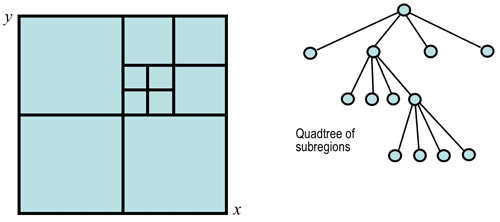
The splitting stage alternates with a merging stage, in which two adjacent regions Ri and Rj are combined into a new, larger region if the uniformity predicate for the union of these two regions, P(Ri ∪ Rj), is TRUE.
Texture segmentation: Spectral features
Grey level or colour pixel values by themselves are not sufficient for segmenting natural highly-textured images like those shown below: |  |  |
| Textured collage | Grey-level histogram | Segmentation by thresholding |
The above two regions (a black object and white background) obtained by simple thresholding are completely meaningless. To find meaningful regions containing different types of homogeneous textures, specific texture measures (features) have to be used like, for example, local spatial signal statistics:
 |  |
| Textured collage | Segmentation using local features |
| (http://www.sztaki.hu/~sziranyi/textu-iu.html) | |
 | |
| Textured collage, actual region map, and segmentation using local features | |
| (http://www.ercim.org/publication/Ercim_News/enw64/mikes.html | |

The "variance" image presents scaled standard deviations σ for each pixel; bright regions in this image signify high local variance of grey levels:
 | 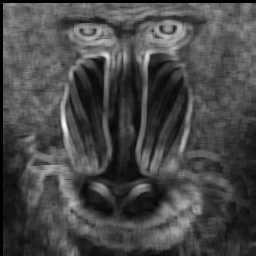 |
| Greyscale image "Baboon" | Variance image (7×7 window) |
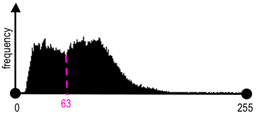 |  |
| Histogram of the variance image | Variance thresholding: T=63 |
References
These lecture notes follow Chapter 10 "Segmentation" of the textbook- Nick Efford. Digital Image Processing: A Practical Introduction Using JavaTM. Pearson Education, 2000.
Return to the local table of contents
Return to the general table of contents
No comments:
Post a Comment